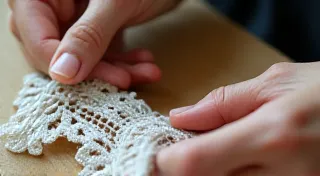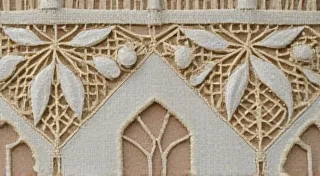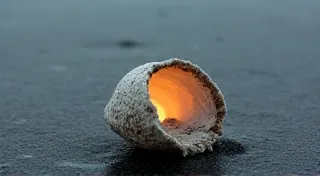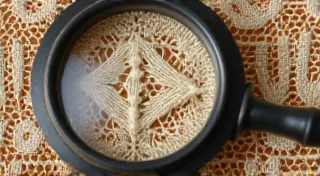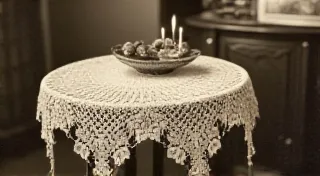Bobbin Lace Tools: Evolution and Identification
The beauty of antique bobbin lace isn't solely a product of the intricate patterns created – it's also intrinsically linked to the tools used to craft them. These tools, often overlooked, provide fascinating insights into the history and evolution of this delicate textile art. Understanding these instruments helps us appreciate the skill and craftsmanship involved in creating these treasures, and even aids in dating and identifying lace pieces. For those new to the intricacies of bobbin lace, understanding the fundamental bobbin lace construction is an excellent starting point.
The Essential Pillow: Foundation of the Craft
At the heart of bobbin lace making lies the pillow. Early bobbin lacemakers utilized simple, hand-carved wooden pillows, often fashioned from readily available materials. These pillows, typically filled with straw, bran, or sawdust, provided a cushioned surface upon which the lace patterns were built. The shape varied; some were rectangular, others more rounded, and sizes ranged considerably. Identifying these early pillows can be challenging, as markings were rare and wear often obscures details. A worn, hand-carved wooden pillow suggests a piece of lace made in the 18th or early 19th century. The pillow is truly the bedrock of the entire process, dictating the tension and form of the emerging lace.
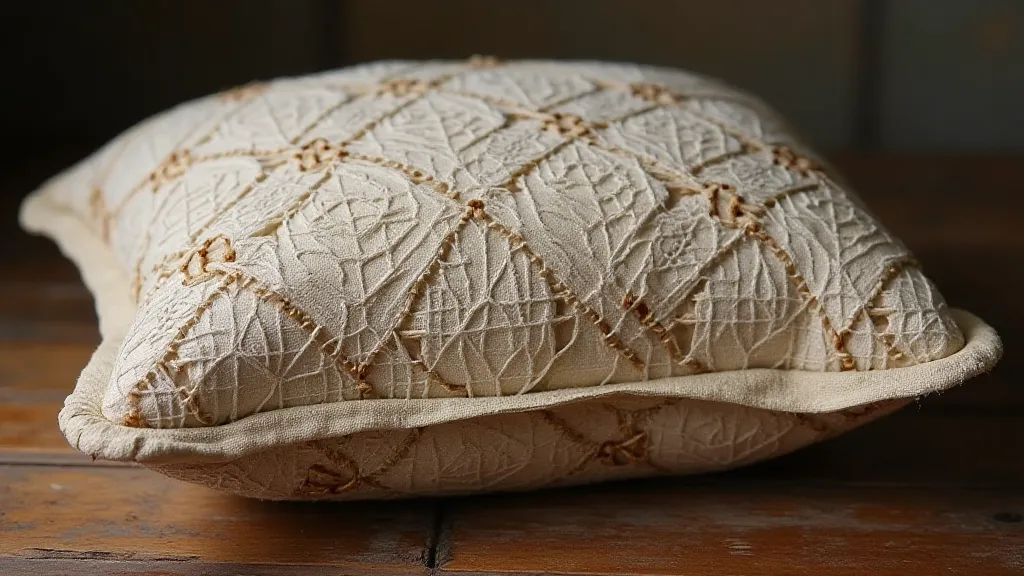
Bobbins: More Than Just Spindles
Bobbins are arguably the most recognizable tools associated with bobbin lace making. While seemingly simple, they've undergone significant evolution. Early bobbins were often fashioned from bone, horn, or wood, frequently made by the lacemaker themselves. These early bobbins were often plain, functional, and unadorned. As the craft became more refined, particularly in the 19th century, bobbins began to be produced commercially. This led to a wider variety of materials, including ebony, rosewood, and ivory. Commercial bobbins frequently featured decorative elements like turned details, painted designs, or even applied metal fittings. Identifying bobbin material and construction can provide clues about the lace’s origin and age; ivory bobbins, for example, were more common during specific periods. The nuances of construction are vast; understanding how these tools work is key to appreciating the final product, and is a distinguishing feature when separating bobbin lace from needle lace.
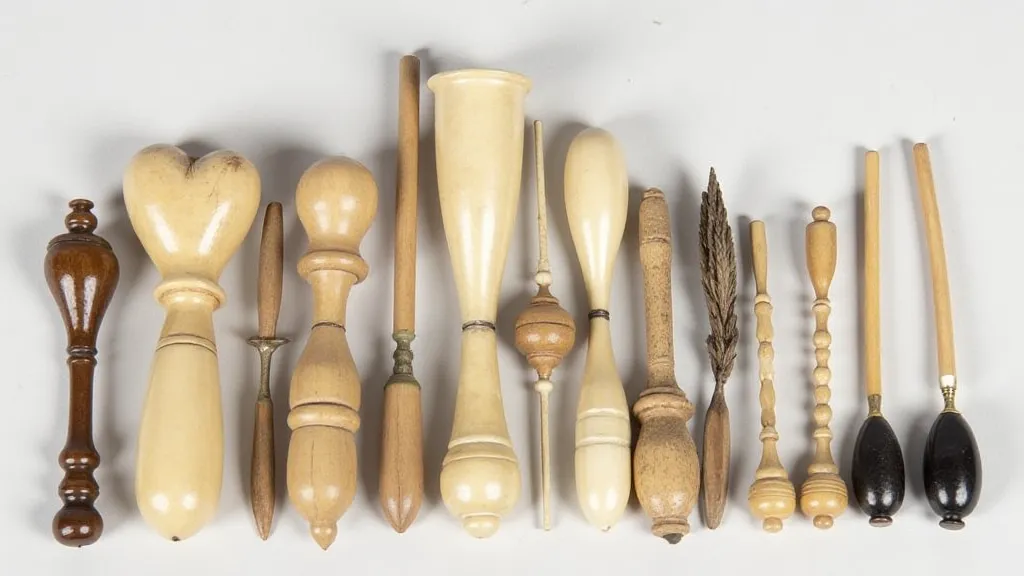
Winding Sticks and Devices: Aiding in Preparation
Preparing the thread for bobbin lace making was a time-consuming process. Early lacemakers relied on simple winding sticks to evenly distribute the thread onto the bobbins. These sticks, often crafted from wood, provided a brace for the thread as it was wound. Later, more sophisticated winding devices were developed, many involving small, hand-powered mechanisms. These devices significantly sped up the winding process and reduced the strain on the lacemaker’
Shears and Scissors: Precision Cutting
Precision was vital in bobbin lace making. Lacemakers relied on sharp shears and scissors to trim the excess thread and define the lace’s edges. While the tools themselves are less distinctive than the pillows or bobbins, variations in handle design and blade style can provide some insight into their age and origin. Small, delicate embroidery scissors were frequently used, reflecting the fine work involved. The meticulous nature of the craft extended to every aspect, including the selection and maintenance of sharp, appropriate cutting tools.
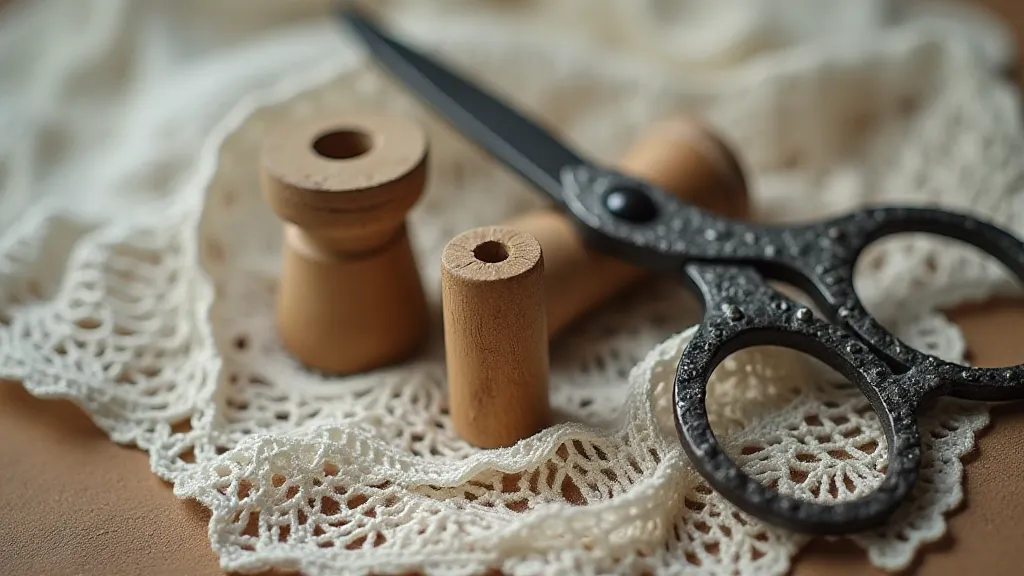
Needles and Other Minor Tools
While not directly used in the primary lace-making process, needles (usually small sewing needles), thread conditioners (beeswax was common), and occasionally small metal tools for adjusting threads were also essential. Finding these tools alongside lace fragments can further contribute to understanding the lacemaking process and the context of their use. These smaller implements, often overlooked in broader discussions, represent the dedication and meticulousness of the craftsperson.
The Art of Faggoting: Integrating Lace with Other Textiles
Beyond the creation of standalone lace pieces, antique bobbin lace frequently found its way into broader textile projects. A particularly fascinating technique is faggoting, where bobbin lace elements are integrated with other fabrics, often linen or cotton, to create decorative panels or embellishments. This process isn's simply about applying lace; it's a careful marriage of textures and patterns, requiring both skilled lacemaking and textile manipulation. The resulting pieces often showcase the versatility and beauty of bobbin lace, extending its applications beyond purely decorative uses. For those interested in exploring the creative possibilities of combining different textiles, learning more about the art of faggoting can be incredibly rewarding.
Dating and Identification: Unraveling the Past
Examining the tools associated with a piece of antique bobbin lace can provide valuable clues about its origin, age, and the techniques employed in its creation. The presence of specific tool types can be surprisingly informative. For example, the prevalence of ivory bobbins suggests a timeframe largely between the mid-18th and early 19th century, although geographic location and economic factors significantly impacted material availability. The presence of hand-carved wooden pillows, in contrast to later, mass-produced versions, points to an earlier date. Similarly, the style and quality of winding sticks or winding devices can offer insights into the workshop and the level of mechanization involved. The complexity of designs often correlated with the quality and number of tools available, particularly bobbins; intricate designs required a larger number of bobbins.
However, it's crucial to remember that tool variation was considerable, and regional differences existed, making identification a nuanced process. A lacemaker’s personal preferences, family traditions, and the availability of materials all influenced their tool choices. Moreover, tools were often reused and passed down through generations, blurring the lines between eras. Therefore, a definitive dating is often difficult, but the presence of specific types of tools can help narrow down the timeframe and provide a more informed appreciation for this remarkable art form.
Further Considerations: Materials and Construction Techniques
Beyond the tools themselves, the materials used in bobbin lace making offer additional clues about the piece's origin and age. Early lace was typically made from linen thread, spun and prepared locally. As the Industrial Revolution progressed, cotton thread became increasingly available and affordable, leading to a shift in materials. The quality and fineness of the thread also varied, affecting the overall appearance and texture of the lace. Understanding the evolution of thread production complements the analysis of the tools used. Early bobbins were often crafted to handle the unique characteristics of handspun linen – a thicker, less consistent material than the later, factory-produced cotton thread.
The construction techniques employed also reveal valuable information. Early lacemakers often used simpler patterns and fewer bobbins, while later pieces often featured more complex designs and a greater number of bobbins. The tension of the thread, the spacing of the motifs, and the overall symmetry of the piece can also provide clues about the lacemaker's skill and the style of the region.
Conclusion: A Window into the Past
Antique bobbin lace tools offer a fascinating window into the past, providing insights into the history, techniques, and artistry of this delicate textile craft. While definitive dating can be challenging, careful examination of these tools, alongside consideration of materials and construction techniques, can help us appreciate the skill and dedication of the lacemakers who created these treasures. By understanding the tools and the processes involved, we gain a deeper understanding of the cultural and economic forces that shaped this remarkable art form.
